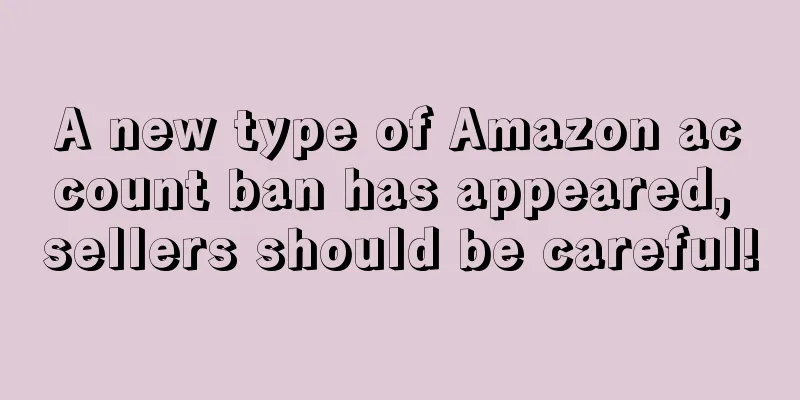Breaking news! Amazon requires sellers to verify "emergency contact information"

|
Today is the seventh day of the Lunar New Year, the last day of the Spring Festival holiday. This Spring Festival, many sellers are full of anxiety and have not had a comfortable time. First, Amazon asked to verify the seller's emergency contact information without any warning, and then, patent/trademark trolls took advantage of the seller's holiday and had no time to respond, and filed malicious infringement complaints, adding fuel to the fire. At the same time, the US Consumer Act verification also came in large quantities, and many problems hit the sellers all at once, making them anxious and troubled. Amazon Verifies Seller Emergency Contact Information In the past few days, a large number of Amazon sellers have received the following emails: In the email, Amazon said it noticed that the seller's emergency contact email address and phone number in the Amazon account have not been verified. In order to maintain the seller's eligibility in the account health protection plan, get timely support from account health experts, and protect the seller's business from potential account interruptions, sellers need to verify this information as soon as possible. During the Spring Festival, sellers suddenly received such an email and were immediately confused. They immediately raised a series of questions: "Will my account be affected if I don't verify it?" "Is there a time limit for verification?" "My number has been cancelled, how can I complete the verification?" It is reported that Amazon only notified the sellers via email this time, and there is no relevant display in the backend performance. Some sellers opened a case for consultation after receiving the email, but were told by customer service not to care. However, to be on the safe side, many sellers still conducted verification. According to sellers' feedback, the verification process is not complicated. Just click the "Update my emergency contact information" link at the end of the email to enter the page and follow the prompts. However, many sellers encountered a problem when verifying their phone numbers. After entering their phone numbers, the page displayed "Unable to process your code request. Please add your phone number again." In fact, Amazon requires sellers to fill in this information for a clear purpose, which is to facilitate timely contact with the seller in case of problems in the future. Therefore, if the seller's phone number has been cancelled, or the reserved number is a landline number, you might as well take this opportunity to update it. If it is inconvenient to verify, or the verification fails, it is okay to wait a while, after all, the email does not indicate what the consequences will be if the seller does not verify. Amazon also issued an announcement on January 30 regarding this matter. The announcement shows that starting from January 24, Amazon requires all sellers to verify their emergency contact number (ECN) through a one-time password (OTP) verification process. However, many sellers are extremely dissatisfied with the timing of the notification. They pointed out that Amazon only issued the notification a week after the verification was launched, which is too slow. Some sellers even suspect that this is Amazon's strategy to suspend non-compliant accounts. In addition, many sellers revealed that they completed the information verification immediately after receiving the first email, but then received 4 identical emails in succession, which made them suspect that these emails were phishing emails. They really don't understand why they keep receiving repeated emails even though they have completed the verification. Seller's TOP 10 links were complained of malicious infringement During the Spring Festival, cross-border sellers not only have to deal with the troubles caused by the platform, but also have to guard against the malicious behavior of patent/trademark hooligans. A few days ago, a seller encountered a bad thing: the product link he spent a lot of effort to create was directly removed by Amazon after someone maliciously complained about copyright infringement. Speaking of this link, the seller invested a lot of money and effort to create it. Before that, he placed advertisements for three consecutive months and finally pushed the link to the top 10 in the category. He thought he would reap the rewards and make a fortune happily, but he didn't expect that the Canadian site would have problems before he was happy. A criminal copied his link and created an identical FBM shipping link. Just two days later, he filed a copyright infringement complaint against the seller. The consequences of this malicious complaint were very serious, and all the seller's links, including the Canadian site, were removed from the shelves. “He used all my pictures, but I was able to file a complaint successfully.” The seller said angrily: “It’s Chinese New Year, and I’m really disgusted.” Now, in addition to the link being removed, the seller's goods are still floating on the sea. Amazon told him that if he wants to resume sales, he can only contact the other party to withdraw the lawsuit. However, based on past experience, in the case of such malicious complaints, if you want the other party to withdraw the lawsuit, you will most likely have to choose to pay a high fee and spend money to avoid disaster. This is the fastest and most worry-free solution for sellers. Generally speaking, if a seller encounters a complaint of malicious infringement and is not in a hurry to resume sales, there are two other ways to deal with it. The first is to file a complaint with the Amazon platform. Write a detailed appeal letter, clearly explain the ins and outs of the matter, and emphasize the malicious complaints. Explain what you have done to prove product compliance, such as providing relevant certificates, contracts and other evidence. Express your sincerity and expectations for resolving the problem, and request the platform to review and restore the link as soon as possible. The second is to initiate legal proceedings. Find an experienced intellectual property lawyer and explain the situation in detail. The lawyer will provide professional legal advice and response strategies, and assess the possibility of winning the case and legal measures. If there is sufficient evidence to prove that the other party has made a malicious complaint and caused significant losses, you can consider litigation to protect your rights and demand compensation and eliminate the impact. US Consumer Act Verification Concentrated Bombing During this Spring Festival holiday, various verifications took place one after another. Amazon sellers not only had to verify their emergency contact information, but also had to deal with the US Consumer Act verification. Many sellers reported that they suddenly received a consumer act verification notice from the platform when they were enjoying the holiday with their families. In fact, this wave of verification started a few days before the holiday. For sellers, the US Consumer Act verification is not a new thing, but some sellers did not dare to handle the verification notices received during the Chinese New Year because they were worried that the IP would have problems when they were away from home. However, according to the notification, Amazon only gave sellers 10 days to process the issue. Therefore, even during the Spring Festival holiday, many sellers rushed to find a way to deal with the issue after receiving the email. The verification operation is not difficult. If the information has not been updated, it can be completed with one click; if the information has changed, the processing process is slightly more complicated. For example, a seller changed the business license address, but received the consumer law verification information before updating it in the Amazon backend. So the seller was struggling with whether to update the business license address in the backend first, wait for the backend to update and then click on the consumer verification, or directly change it in the consumer law. Which of the two methods is safer? Sellers need to note that if the relevant information changes, they must update it and then re-certify it, otherwise it is easy to cause problems. Previously, a seller mentioned that the address of his business license had changed, but when he received the Consumer Act verification, he did not edit and update the address, but directly certified it. Although it was passed on the same day, he received the same certification email later. This puts sellers in a dilemma, as they are struggling over whether to repeat the verification, while also worrying that repeating the Consumer Law verification will have a negative impact on their accounts. How was your holiday? Tomorrow we will start working hard. In 2025, let’s rush towards our goal! Amazon Emergency Contact Verification |
<<: Successfully rang the bell! Shaoxing boss went from losing money to becoming the world's top 3
>>: Focus on niche products! Ningbo sells well and doubles profits
Recommend
With the merger of the two giants, small and medium-sized sellers on Amazon may suffer a dimensionality reduction blow!
In the past few years, Amazon has grown rapidly d...
As the epidemic situation "rises", Dongguan Lens Technology suspends production activities!
Affected by the new round of epidemic, Lens Techn...
Sellers' Quick Look: Four Strategies to Stimulate Customer Repurchase
It’s no secret that it costs more to acquire a ne...
Selling out! Shenzhen's biggest seller made 150 million yuan on Amazon with 10 SKUs
In recent years, the 3C consumer electronics mark...
Chinese products are a big hit! Search volume soars 2900%, "Chinese health magic tool" is popular overseas
Father's Day has once again set off a shoppin...
What is Feedback Genius
Feedback Genius is a third-party tool from Amazon...
The development of "buy now, pay later" is hindered, and the UK will legislate for regulation
The "buy now, pay later (BNPL)" service...
Small and medium-sized foreign trade enterprises have a good start. One merchant on Alibaba International Station shipped 8 containers at once.
This year, small and medium-sized foreign trade e...
What is Locad? Locad Review, Features
Founded in Manila and Singapore in October 2020, ...
What is KnownOrigin ? KnownOrigin Review, Features
KnownOrigin is a marketplace for discovering and ...
AliExpress warehouses will remain open during the Spring Festival! 60% advance loan, free warehouse rent, exclusive traffic...
Since the full launch of semi-hosting, AliExpress...
29,500 blowers recalled due to fire hazard
Friends who are opening a shop or renovating thei...
Demand for Easter products in Russia surges by 150%, with many categories selling well
Recently, Russian online retailer Pyaterochka rel...
What is Uala? Uala Review, Features
<span data-docs-delta="[[20,{"gallery"...
Latest! Sellers of POE insurance begin to protect their rights
Regarding the POE insurance policy explosion, som...









